Indian Architecture – India’s Rich Architectural Tapestry Unveiled
Let’s have a look at Indian architecture today. We will examine some of the historical development of this particular architectural heritage, a number of traditional elements in Indian architecture, and a few famous Indian buildings. There is much to learn about when it comes to the architectural heritage of India, so let’s get started on this discussion and have a look at Indian architecture!
Table of Contents
- 1 A Look at Indian Architecture
- 2 The Marvels of Ancient Indian Architecture
- 3 The Influence of Islamic Architecture in India
- 4 Colonial Era and the Fusion of Styles
- 5 Traditional Indian Architectural Elements
- 6 Vernacular Architecture: Diverse Regional Styles
- 7 Contemporary Indian Architecture
- 8 Iconic Indian Architectural Landmarks
- 9 Frequently Asked Questions
A Look at Indian Architecture
Indian architecture, in very basic terms, is any architecture in India. This is a rather obvious statement, but it is worth stating because there is no actual style known as “Indian architecture” as a fully unified style.
There are a multitude of different architectural styles that fall under the general purview of Indian architecture in general, and so that is what we are going to be examining today. Let’s get started.
The Marvels of Ancient Indian Architecture
There are many stunning examples of the historical architecture of India, and below, we will discuss a few of the major styles that have led to the development of Indian architecture. Some of these ancient styles have become immensely influential in the modern era.
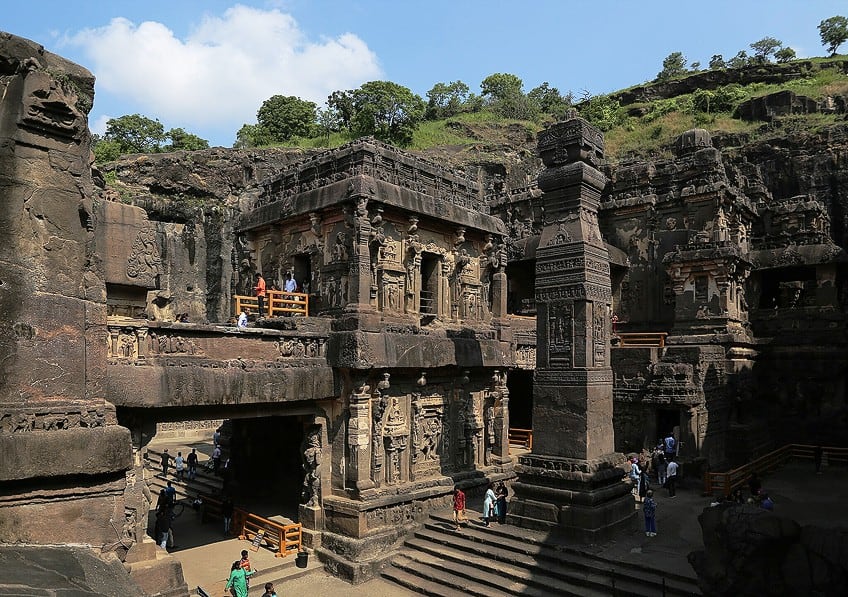
The Magnificence of Hindu Temple Architecture
Some of the greatest and most famous architecture in India can be found in the great Hindu temples. These temples make use of intricate carvings and sculptures that depict various entities and figures from the Hindu religion and texts, and the use of monumental scale and grandeur. Within these designs, there are two major variations, namely the use of Nagara architecture, which led to the development of more curvilinear towers, and Dravida architecture, which makes use of pyramidal towers.
However, these temple designs have become some of the most magnificent in the world.
Buddhist Architecture: From Stupas to Monasteries
When it comes to Buddhist architecture in India, there are three main types of structures. There are stupas, which are hemispherical mounds that contain relics, and they are often surrounded by a fence of some kind as well as a tower or spire.
There are also temples, which are generally rectangular, make use of vaulted roofs, and are decorated in art that depicts the life of the Buddha and other figures. And there are monasteries, which are larger complexes meant for the everyday life of the monks who choose to live within the walls, and they are integral to the development of the Buddhist faith. As Buddhism was born in India, it makes sense that it would have some of its oldest origins within this country.

Jain Architecture: Temples of Serenity and Intricacy
Many Jain structures adapt their style based on the time period and region in which they were designed and constructed. However, there are many stunning examples of these structures, such as the Dilwara Temples in Rajasthan. Most Jain structures are temples and monasteries.
The Influence of Islamic Architecture in India
For many centuries, there has been an Arabic influence in India. Some of the earliest instances of this trace back to the 8th century when Arabic invaders conquered the Sindh region and incorporated it into the Umayyad Caliphate. Arabic influence would continue to press its way into Indian architecture, and this would increase with Turkish and Afghan dynasties in the 12th century. These new conquerors would bring Islamic architecture with them, and this architectural style would have an influence on Indian architecture that can still be felt in the present day.
The Islamic style would eventually blend with more Indian architectural styles into an Indo-Islamic fusion.
This conjoined style was generally constructed by Islamic people for their own purposes, such as its use in mosques that made use of traditional Islamic components, such as minarets and mihrabs, with Indian designs incorporated into them. However, it was with the advent of Mughal architecture that some of the most famous Indian buildings were constructed, such as the Taj Mahal. This particular style arose during the rule of the Mughal emperors, which was an Islamic dynasty that continued the development of an Indo-Islamic architectural style that would have considerable influence.

These structures were often grand in their design and often made use of red sandstone and marble. The legacy of Indo-Islamic architecture in India is an important one. It led to the development of various regional and vernacular architectural styles throughout the country, and it has gone on to influence some of the most famous Indian architects who are still operating to this day.
The style has become part of Indian architecture in general and contemporary Indian architecture can often not be separated by its shared history with Islamic architecture.
Colonial Era and the Fusion of Styles
One of the major events that occurred in the history of India in many areas was the advent of colonialism. This affected the culture of the country and the architectural designs. Some of the earliest Europeans, such as the Portuguese, French, and Dutch had an influence on the way in which Indian architecture evolved from as early as the late 15th century. However, it was the appearance of the British rule over the country from 1858 that had the most profound impact on the architectural heritage of India.
Although, they had been pressing into the country and controlling more of it for decades already, and so 1858 is only the official start of complete control.
The British Raj, as the period is known, had an overwhelming influence on the development of architecture in the country. During this period of time, the British colonizers introduced an array of European architectural styles to the country and implemented these designs in many of the public structures that they designed, such as governmental buildings and railway stations. This would be a long-standing influence on the development of architecture in the country and many of these structures remain to this day.

In addition to these more European styles that were introduced to India, there was also the advent of a late-19th century Indo-Saracenic architectural style that was used as a form of revival architecture during the British Raj. The idea was to merge Indian, Islamic, and European styles together to create something new. This style was, in part, influenced by certain orientalist mentalities that saw Indian culture as exotic.
This architectural style would go on to have a lasting influence on Indian architecture.
Traditional Indian Architectural Elements
There are a number of elements in traditional Indian architecture that are worth discussing in some detail. One of the most predominant is the concept of Vastu Shastra. This is an ancient means of approaching architecture in India that involves very specific means of arranging and laying out spaces. A significant portion of the ancient texts are now considered to be superstitious, but the concept is still a strong one in present Indian architecture. One of the reasons is because Vastu Shastra calls for strong harmony between the natural environment and what has been created by humans.
This allows for a more sustainable approach to architecture, especially in the contemporary era. This will be discussed in slightly more detail in one of the sections below.
Other common elements that can be found throughout the architectural heritage of India are the use of jali and filigree arrangements. The former of these refers to the use of lattice stone screens that were commonly used in both Indian and Islamic architecture. They have commonly been used in walls and windows, especially for the purpose of ventilation in hot environments. Filigree, on the other hand, refers to metalwork designs that are used to design and create delicate and intricate decorative elements that can be used as decoration for structures.
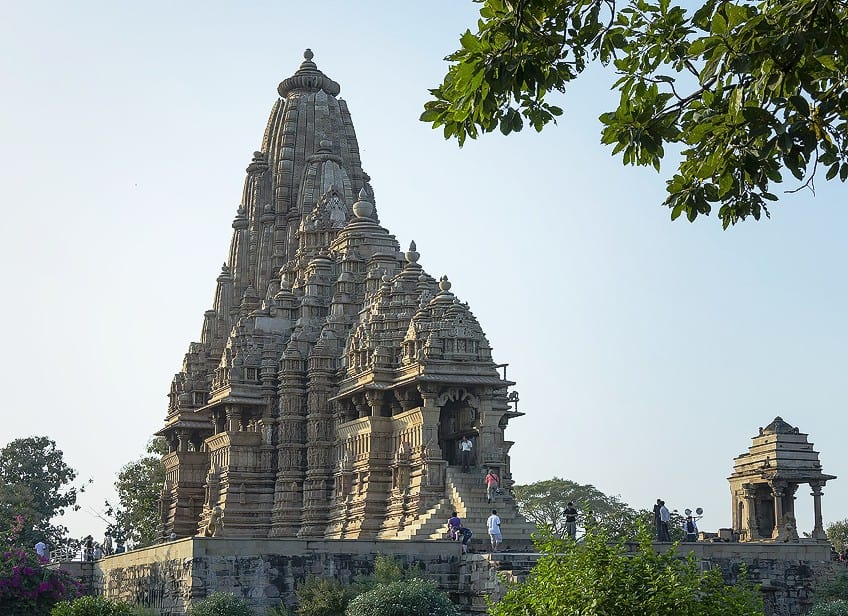
Another important component of Indian architecture is the use of courtyards, which allow for tranquil, often landscaped, areas within structures. In addition to this, stepwells are often used as a means of conserving water as well as using it as a means of irrigating gardens and providing drinking water.
However, none of these elements are necessarily used in more contemporary Indian architecture.
Vernacular Architecture: Diverse Regional Styles
While we have examined a number of the most famous Indian buildings and those that have formed part of the cultural and architectural heritage of India as a whole, it is also worth discussing the lesser-known aspects of Indian architecture. There are numerous aspects of vernacular architecture in the country, meaning individualized and local designs that do not necessarily conform to the major architectural styles and trends.
In the case of the vernacular architecture of India, there are many traditional houses and havelis located in the Rajasthan region that are known for their use of colorful designs and intricate layouts.
Many of these traditional homes are constructed around large courtyards with sandstone or marble materials used. These structures also tend to make use of flat roof designs. There are also palatial houses in the Chettinad architectural tradition that instead make use of a more international style. They have taken inspiration from some of the Western influences that have entered the country since the colonial era and combined them with local sensibilities. Many of these structures have become known for their scale, use of color, large and spacious rooms, and the large courtyards that are constructed as enclosed spaces around which rooms are arranged.

And there are also the stunning examples of the traditional wooden structures in the state of Himachal Pradesh. These particular structures are known for making use of more sustainable local materials such as wood, mud, and stone, and they include sloped roofs, carvings, and paintings throughout their construction. While there are many important influential aspects of Indian architecture that can be found throughout the country, it is often in the vernacular spaces where some of the more interesting and individualized locations can be found.
This has only been a short list of the vernacular architecture that can be found in India, but there are many other instances that could be found.
Contemporary Indian Architecture
The contemporary era, throughout the world, has been influenced by the increases in technology and the homogenization of architectural standards around more modern sensibilities. In terms of Indian architecture in the contemporary era, much of it has its origins in the colonial era of the country as that lengthy period was an important one in the history of the country. However, contemporary standards have also led to a combination of those colonial influences alongside local designs.
There are a number of famous Indian architects operating today, such as Raj Rewal, who designed structures such as the State Trading Corporation building in New Delhi, and B.V.
Doshi, who designed the National Institute of Fashion building in New Delhi. Many of these contemporary structures in the country are simultaneously modern and reflect internationalist tendencies, but also incorporate elements of more traditional Indian architecture. Like many countries around the world, a move towards sustainable architecture has become increasingly prominent throughout Indian architecture.
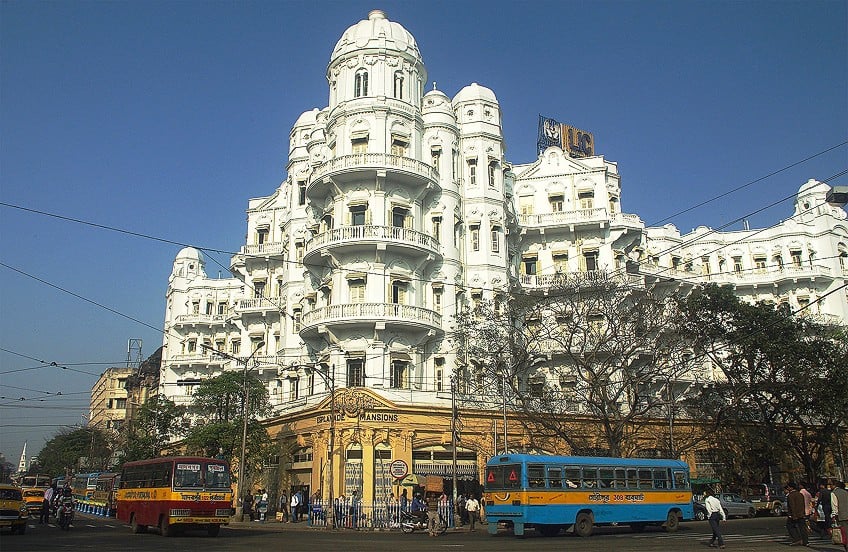
This has often meant the use of local materials, renewable energy, low-cost and low-energy construction, and a general move towards Vastu Shastra architectural sensibilities in which the natural landscape is incorporated into the design of the structures. However, contemporary architecture is far from complete and stable, and it is instead geared towards new challenges and needs as they appear in the country.
For instance, the ever-increasing rate of urbanization in the country has led to a further need for improved urban planning and design.
Iconic Indian Architectural Landmarks
There are many examples of gorgeous and historical architecture in India that are worth examining and discussing, and so we shall now look at the architectural heritage of India through five of the most famous Indian buildings. These structures date from ancient times into the early-20th century. However, there are many later instances of famous architecture in India that are also worth discussing. Let’s start with these though.
The Khajuraho Temples (Around 950 – 1050) in Khajuraho
| Architect | Possibly Vidhyadhara (Ruled 1017 – 1029) |
| Date Constructed | Around 950 – 1050 |
| Function | Tourist attraction and place of worship |
| Materials Used | Granite and sandstone |
| Location | Khajuraho, India |
The Khajuraho Temples are some of the most stunning examples of famous architecture in India, and these temples are considered to be the greatest and most ornate of all the temples from this era. The present structure was originally constructed under the orders of the famous Chandela ruler, Ganda, in the 11th century, but there are aspects of the temple that may be older than that.
The structure, as a whole, is dedicated to Shiva, one of the principal deities of the Hindu faith and an immensely important figure in the religion.
The temple, because of its dedication and the innate structure that it takes, is also filled with numerous sculptures and carvings. Many of these have become famous for their erotic subjects. Other than the famous art that covers this piece of historical architecture in India, the temple itself is also considered to be a stunning example of the Nagara style. It makes use of a high platform with a central shrine around which other shrines are located. It is also constructed around a combination of an entryway, a main hall, a vestibule, a sanctum, and passageways.
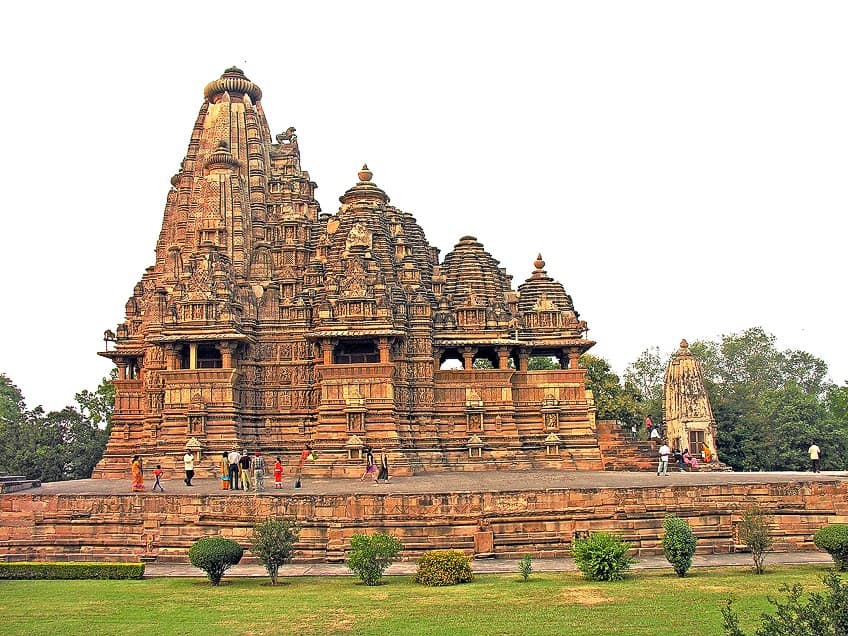
This particular temple was constructed through the use of sandstone bricks, and it is a fantastic example of this particular strain of Indian architecture as it was assembled without the use of mortar and cement. The blocks are instead cut and precisely fit together to ensure the structural stability of the entire temple.
The Meenakshi Amman Temple (16th – 17th Centuries) in Madurai
| Architect | Unknown |
| Date Constructed | 16th – 17th centuries |
| Function | Place of worship |
| Materials Used | Granite and stucco |
| Location | Madurai, India |
The Meenakshi Amman Temple is a gorgeous temple complex located in Madurai with a present structure dated to around the 16th and 17th centuries. However, the site itself may have been used as a place of worship far longer and may have been used as early as the 4th century. This also means that this stunning example of historical architecture was constructed atop an already immensely important and sacred location.
This famous Indian building is considered to be an exemplary example of Dravidian architecture. It is arranged around high walls that protect the tall towers within.
Each of these towers, known as gopuras, is intricately detailed, colorful, and filled with colonnades, shrines (of both the lesser and greater varieties), and a sacred tank. These particular gopuras are the most elaborate and intricately decorated examples of this already famous aspect of the architectural heritage of India. The temple complex is also still used to this day as a living temple. There are ceremonies performed weekly, hymns are sung, and the location is used for the annual Teppa festival.
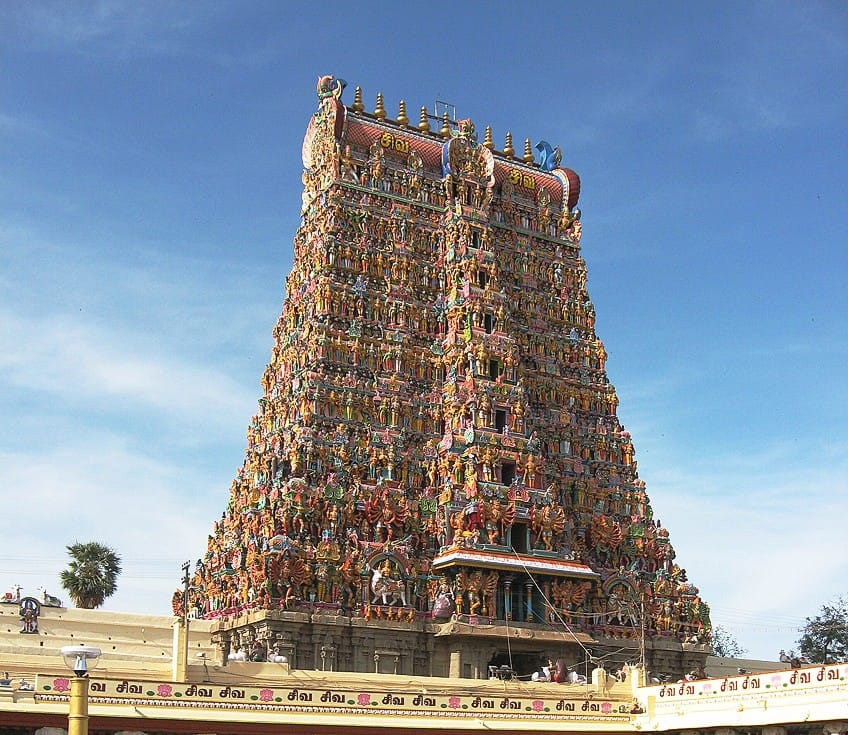
However, while the site has remained an important temple that is still in use, it has also become a prominent destination to visit. The building itself may be an exemplary example of Indian architecture, but it is also decorated with many murals and other examples of artistry that it is worth visiting and seeing the stunning work on display. The many columns that are located throughout the temple complex are also intricately carved with images of divine and mortal figures.
The Golden Temple (16th Century – 1830) in Amritsar
| Architect | Various |
| Date Constructed | 16th century – 1830 |
| Function | Place of worship |
| Materials Used | Marble, copper, gold, and wood |
| Location | Amritsar, India |
The Golden Temple is one of the most famous Indian buildings, but it is also somewhat unique in its general design. It has been considered to be a combination of Hindu Rajput and Mughal architecture. The temple has attained its name because of the golden color of the general design of the structure and the stunning exterior that rises out of the surrounding landscape like something utterly different from everything around it.
The Golden Temple includes a number of ornate domes, windows with carved brackets, various instances of ornamentation on the façade, numerous arches, and an elaborate array of mural artworks throughout the design of the structure as a whole.
It is a truly stunning aspect of the architectural heritage of India. In this particular case, unlike some of the other structures we have thus far examined, this particular structure is instead considered to be one of the most important and holiest locations within Sikhism rather than Hinduism.

This famous Indian building served as the most important shrine in this faith during the mid-20th century, but it was forced to alter during the 1980s because of conflicts with the Indian authorities. However, the site is still open to this day and, even though it is a Sikh temple, it is considered to be an open house of worship. This means that anyone from any faith can enter and use the site as a place of worship.
The Taj Mahal (1631 – 1653) in Agra
| Architect | Ustad Ahmad Lahori (17th century) |
| Date Constructed | 1631 – 1653 |
| Function | Mausoleum |
| Materials Used | White marble |
| Location | Agra, India |
The Taj Mahal is most definitely the most famous Indian building. This structure has become one of the most famous buildings ever constructed, and in 2007, when a new list of Wonders of the World was being established, the Taj Mahal made it onto that list. So, this particular structure has received numerous accolades and has become a symbol of India itself and an important piece of tourism in the region.
However, the story of the structure is what often drives many toward this particular building. It was constructed under the order of Shah Jahan, one of the greatest Mughal emperors for his late wife.
It took over two decades and 20,000 workers to complete the Taj Mahal, and because of the immense labor that went into creating this piece of famous architecture in India, it has become one of the most enduring symbols of love in the world. The structure itself is also considered to be one of the most important in the history of Indian architecture. The structure makes use of a number of different styles taken from Islamic, Persian, and Indian sources, and it includes a symmetrical design, a stunning onion dome, a gorgeous array of gardens, and walls that are covered in intricate decorative elements.

This particular structure has become one of the most visited in the world, and its fame, beauty, and contribution to both the cultural and architectural heritage of India cannot be overstated. When it comes to famous Indian buildings, you don’t get more famous or illustrious than the Taj Mahal.
The Gateway of India (1914 – 1924) in Mumbai
| Architect | George Wittet (1878 – 1926) |
| Date Constructed | 1914 – 1924 |
| Function | Monument |
| Materials Used | Basalt and concrete |
| Location | Mumbai, India |
The Gateway of India is an early-20th-century monument in one of the most famous cities in India, Mumbai. The structure is a part of the colonial heritage of the Indian subcontinent, and it was actually designed to commemorate the arrival of George V, the first British monarch to actually visit India even though the British monarchs had styled themselves as the “Emperors of India” since 1876.
The structure itself is constructed of basalt and was meant to continue the ancient triumphal arch tradition that was established in ancient Roman architecture.
Ever since it was constructed, it was used as a monument through which colonial personnel would pass. It also actually has an important role in the end of colonialism in the country as it was through this monument that the final British troops ceremonially exited the country in 1948. While the arch may have its origins in the colonial history of the country, it has become one of the premier tourist destinations in the city. It has also become an important location for the local Jewish community as it has been used for Hanukkah celebrations since the early-2000s.
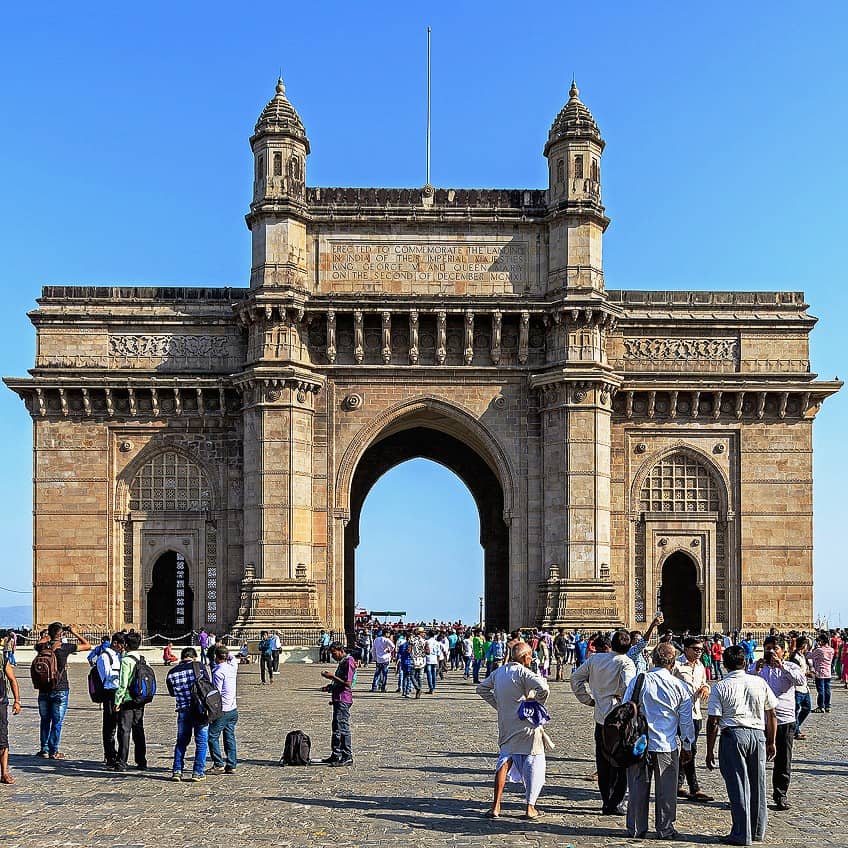
However, there have been attempts made to damage the monument, such as a 2003 terror attack that saw the detonation of an explosive device at the site. Since 2019, there have been plans to further develop the area around the arch as it is an important part of the architectural heritage of India’s colonial past and a much-visited tourist destination.
And so, we finish off our look at Indian architecture. We have examined a number of different elements of this national architectural style, such as some of the earliest instances, certain design characteristics, and a number of famous Indian buildings. However, there is always more to learn when it comes to any architectural style, and Indian architecture is no different!
Frequently Asked Questions
What Is Indian Architecture?
Indian architecture is any architecture that is related to the Indian subcontinent. The country has a rich and complex history that has led to an integration of Hindu, Islamic, Saracen, and other influences throughout the architectural heritage of India. However, there is no singular thing that is Indian architecture, and it instead refers to a variety of styles that can be found throughout the history of the country.
What Are the Key Features of Indian Architecture?
Some of the most common characteristics of Indian architecture include the use of precise geometric design, square layouts, the use of tall tower designs, arched windows, and decorative sculpted elements and patterns. However, it is worth remembering that there is no unified Indian architectural style and there is instead a multitude of differing styles that each have their own specific features.
How Does Indian Temple Architecture Differ from Other Styles?
Indian temple architecture comes in a vast array of styles, especially based on the particular faith in question and the period during which the structure was designed. However, with regard to Hindu temples, which are the most predominant in the country, they all generally retain an inner sanctum design where the central deity of that temple is housed. There are variations around this central design necessity.
What Are the Symbolic Representations in Indian Temples?
Indian temples are usually decorated in symbolic representations through the use of frescoes, carvings, and statues. These temples are often dedicated to a variety of deities, and so the representations that can be found within them are indications of the rich historical background of these figures. In addition, temples themselves in the Hindu faith are considered to be cosmic pillars that allow better communication with the gods.
What Is the Most Famous Example of Indian Architecture?
The Taj Mahal is, by far, the most famous of all the Indian structures. The building, while technically a combination of both Indian and non-Indian architectural styles, has become one of the most famous buildings in the world. It has even become one of the New Seven Wonders of the World and one of the most important and oft-visited tourist destinations in the entire country.
Justin van Huyssteen is a freelance writer, novelist, and academic originally from Cape Town, South Africa. At present, he has a bachelor’s degree in English and literary theory and an honor’s degree in literary theory. He is currently working towards his master’s degree in literary theory with a focus on animal studies, critical theory, and semiotics within literature. As a novelist and freelancer, he often writes under the pen name L.C. Lupus.
Justin’s preferred literary movements include modern and postmodern literature with literary fiction and genre fiction like sci-fi, post-apocalyptic, and horror being of particular interest. His academia extends to his interest in prose and narratology. He enjoys analyzing a variety of mediums through a literary lens, such as graphic novels, film, and video games.
Justin is working for artincontext.org as an author and content writer since 2022. He is responsible for all blog posts about architecture, literature and poetry.
Learn more about Justin van Huyssteen and the Art in Context Team.
Cite this Article
Justin, van Huyssteen, “Indian Architecture – India’s Rich Architectural Tapestry Unveiled.” Art in Context. September 13, 2023. URL: https://artincontext.org/indian-architecture/
van Huyssteen, J. (2023, 13 September). Indian Architecture – India’s Rich Architectural Tapestry Unveiled. Art in Context. https://artincontext.org/indian-architecture/
van Huyssteen, Justin. “Indian Architecture – India’s Rich Architectural Tapestry Unveiled.” Art in Context, September 13, 2023. https://artincontext.org/indian-architecture/.









